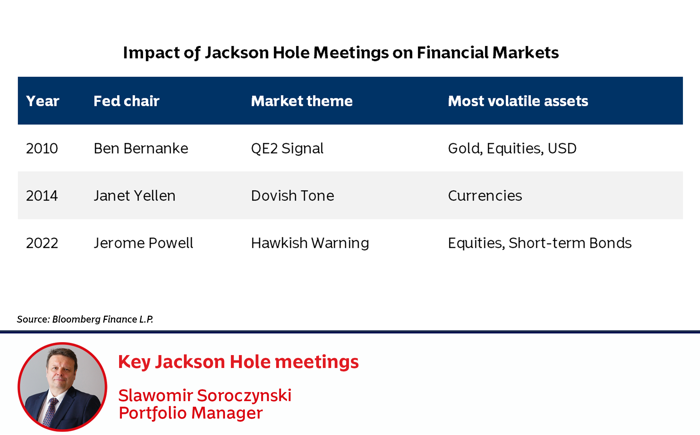
What this chart shows
The table above highlights key Jackson Hole meetings in the post-Great Financial Crisis era. Jackson Hole is an annual Economic Symposium hosted by the Federal Reserve Bank of Kansas City. It is a closely watched event where central bankers, economists, and policymakers gather to discuss major global economic issues. Although it is not a policy-setting meeting, speeches—especially those delivered by the Federal Reserve Chair—can offer critical insights into the future direction of monetary policy.
Impact on Financial Markets
1. Interest Rate Expectations Markets tend to react sharply to any indications about future interest rate moves. If the Fed Chair signals a shift toward tightening (rate hikes) or easing (rate cuts), expectations can adjust swiftly.
2. Market Volatility The event often causes short-term spikes in volatility due to unexpected comments or shifts in tone from policymakers.
3. Investor Sentiment Jackson Hole can shape investor confidence and risk appetite, especially when the macroeconomic outlook is presented in stark or uncertain terms.
Asset Classes Most Affected
1. Currencies The U.S. dollar is highly sensitive to any perceived changes in Federal Reserve policy.
2. Bonds U.S. Treasury yields—particularly the 2-year and 10-year notes—often react to the policy tone, reflecting changes in interest rate expectations and inflation outlook.
3. Equities Stock markets, especially rate-sensitive sectors such as technology and financials, can experience significant moves based on changes in liquidity expectations and borrowing costs.
4. Gold and Commodities As traditional safe-haven assets, gold and other commodities often move inversely to the dollar and are influenced by discussions about inflation and interest rates.
Why this is important
In summary, the Jackson Hole meetings serve as pivotal moments for financial markets, capable of triggering significant shifts in asset prices—particularly in currencies, bonds, and equities—based on the guidance and tone set by central bankers.
Given today's elevated asset valuations, ongoing geopolitical tensions, and uncertainty surrounding future economic growth and inflation, investors are likely to be especially sensitive to any unconventional ideas or comments. These could have a profound impact on market dynamics.
Markets are buoyed by hopes of monetary easing-particularly in the US-and temporary trade respite. But beneath the surface, worrisome signs-including inflation divergence, economic deceleration in China, political risks in Japan, and geopolitical tensions-signal a cautious road ahead for global finance.

-
The Federal Reserve is under scrutiny ahead of this weeks’ Jackson Hole Meeting, with Chair Jerome Powell expected to clarify rate-cut intentions amid internal dissent.
-
A Reuters poll anticipates rising long-term Treasury yields, driven by tariff-related inflation concerns and increased debt issuance, even as short-term yields fall on Fed easing expectations.
-
Stock markets rallied mid-week: the S&P 500, Dow, and Nasdaq hit new highs on expectations of Fed rate cuts, though tech names wobbled
-
On 11 August, US markets dipped modestly as investors awaited key inflation data, while Intel and AMD agreed to remit 15 % of China-related chip revenue to the US in exchange for export licences.

-
UK Inflation is rebounding -July’s CPI climbed to 3.7%, services inflation hit 4.8%, undermining expectations of rapid rate cuts by the Bank of England.
-
American investors have injected over $15 billion into UK equities year-to-date, drawn by valuation appeal and political stability.
-
The Bank of England lowered estimated quantitative tightening losses, while corporate profit warnings (e.g., Thames Water) and a cooling jobs market added caution.
-
Boosted by a US-China trade truce and improved earnings, the FTSE 100 gained moderately mid-week.

-
The planned US/EU joint trade statement is stalled by disagreements over digital regulation: the EU insists on its Digital Services Act while the US objects to its impact on free speech and American tech firms.
-
European markets benefited from global risk-on sentiment alongside US equity gains, though scepticism remains about the broader impact of recent trade deals.
-
Geopolitical developments-such as delays in Ukraine peace negotiations and potential US-Russia Arctic energy deals-are increasing pressure for boosted European defence spending.
-
Overall EU business confidence is waning manufacturing and sentiment indicators lag despite cautious optimism following trade developments.

-
The US-China tariff truce was extended another 90 days, providing temporary relief to exporters and markets. China’s July data revealed a clear economic slowdown: industrial output rose just 5.7 %, retail sales 3.7 %, the weakest since late 2024. Fixed investment remained sluggish at 1.6 %.
-
Trump called his meeting with Russian President Vladimir Putin in Alaska as "productive" but indicated that a path to end the war had still not been finalised. Zelenskiy and his European allies will seek solidarity with the US as Donald Trump hosts them for talks to set out terms for a possible Ukraine-Russia peace deal. “Zelenskiy can end the conflict almost immediately if he wants to”, Trump posted on Truth Social.
-
Japan’s Nikkei climbed past 43,000 for the first time, extending a multi-day rally aided by US market gains and softer inflation data.
-
US moves to limit India ties over Russian oil highlight shifting alignments across global supply chains.
